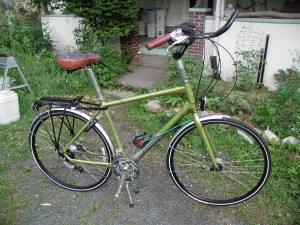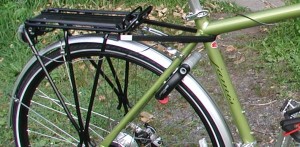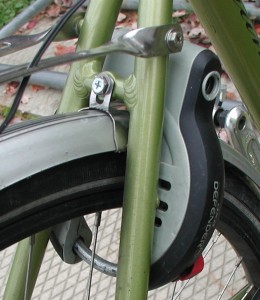 Since I mentioned the lock last week I thought it is time I write some about them and bike security.
Since I mentioned the lock last week I thought it is time I write some about them and bike security.
You may not be able to tell, from the picture, but the bike there has a lock on it. And the lock is locked.
Leaving a bike unlocked in a public place is not very safe anywhere. However, so far, part of my security was, that my bikes looked too off-standard, specialized, altered, chipped, duct-taped and plain strange, that I felt confident they wouldn’t attract unwanted attention from people who are taking bikes to make money. They mostly know what sells easily, so they are looking for standard bikes which would easier go under the radar, but hopefully good looking and fairly good quality, so with one sale they can make good money. I know I am going out on a limb here with generalizing like this, but when the bicycle is looked at as a sport accessory one can’t really sell a heavy bicycle built for stability, accessorized for commuting and general use, especially if it is in any way shabby-looking as well.
This is not true for my current commuter bike, shown above – for the first time in my biking history I ended up with something really appealing (at least to me), so I wanted to take good care of it, and keep it safe too. Thus the lock.
 Here I show the area of the bike where the lock is installed. It is the black object with a bit of red on the bottom (the lock lever). The lock is shaped like a ring, and can lock around the rear wheel rim, stopping the wheel from turning. This one comes with a cord that fits into the gray hole visible close to the top of the lock, so looping the cord around anything not only makes the back wheel is fixed, but the whole bike is fixed to what the cord is looped around.
Here I show the area of the bike where the lock is installed. It is the black object with a bit of red on the bottom (the lock lever). The lock is shaped like a ring, and can lock around the rear wheel rim, stopping the wheel from turning. This one comes with a cord that fits into the gray hole visible close to the top of the lock, so looping the cord around anything not only makes the back wheel is fixed, but the whole bike is fixed to what the cord is looped around.
The way we are looking at bicycles is changing fast, and every year I see more people using their bikes regularly to get somewhere and they are not in Lycra either. In the Netherlands you wouldn’t leave the worst looking rusty, single speed bike unlocked as any kind of bike can be used to get to somewhere faster than walking as long as it functions, so it will sell no matter how it looks.
So it may be taken. Unless it is locked.
So let’s look at locks a bit. My favorite kind of bike locks are:
- Easy to use,
- There when I need them
- An effective deterrent
So forget about wire-locks that can be snipped with a bolt-cutter that is available at any hardware store, or a larger U lock, that is possible to brake with cooling it until it becomes brittle and then hitting it so it breaks, or cutting either with a battery powered grinder with a cutting blade, without hurting the bike in the process.
 The lock pictured here, that fits all my criteria, comes from AXA. I lately figured out that it can be bought on Amazon, but the one pictured above is still from the Netherlands. It is mounted on the bike, with the key only removable when the unit is locked, so it is indeed always available. It is easy to use all right, only takes about 1.5 seconds if that much, for locking and even shorter for unlocking if the key is in your hand as you approach the bike. It is currently confusing in the US, as people (including the ones stealing bikes) are not familiar with it the least. That leads to confusion, that I was lucky to observe once with my own eyes. Two people started to investigate my locked bike, which only was locked to itself without the extra cable, as I was eating lunch outside nearby. One of the guys first tried to push the bike off, as I was much taller than him, so it was clear to him that he couldn’t use the bike normally with such tall seat. He got confused because the back wheel didn’t roll, studied the situation, but then they quickly abandoned the project as he seemed to not be able to wrap his head around what was happening. So the lock is an effective deterrent, even if it isn’t used in high-security mode with the cable, which makes the locking mechanism more obvious. My feeling is, that even then, ‘experts’ will realize that something is different, and in this case you really are not eager to learn new things ‘on the job’.
The lock pictured here, that fits all my criteria, comes from AXA. I lately figured out that it can be bought on Amazon, but the one pictured above is still from the Netherlands. It is mounted on the bike, with the key only removable when the unit is locked, so it is indeed always available. It is easy to use all right, only takes about 1.5 seconds if that much, for locking and even shorter for unlocking if the key is in your hand as you approach the bike. It is currently confusing in the US, as people (including the ones stealing bikes) are not familiar with it the least. That leads to confusion, that I was lucky to observe once with my own eyes. Two people started to investigate my locked bike, which only was locked to itself without the extra cable, as I was eating lunch outside nearby. One of the guys first tried to push the bike off, as I was much taller than him, so it was clear to him that he couldn’t use the bike normally with such tall seat. He got confused because the back wheel didn’t roll, studied the situation, but then they quickly abandoned the project as he seemed to not be able to wrap his head around what was happening. So the lock is an effective deterrent, even if it isn’t used in high-security mode with the cable, which makes the locking mechanism more obvious. My feeling is, that even then, ‘experts’ will realize that something is different, and in this case you really are not eager to learn new things ‘on the job’.
